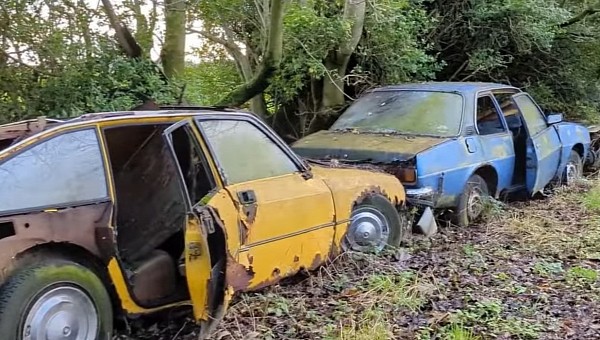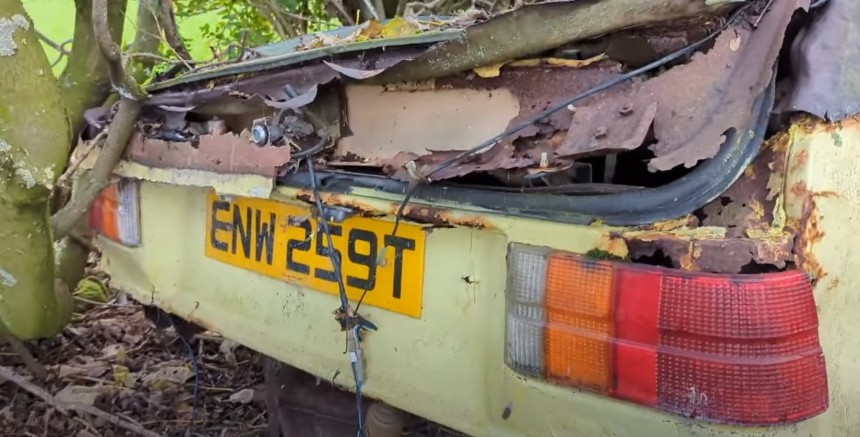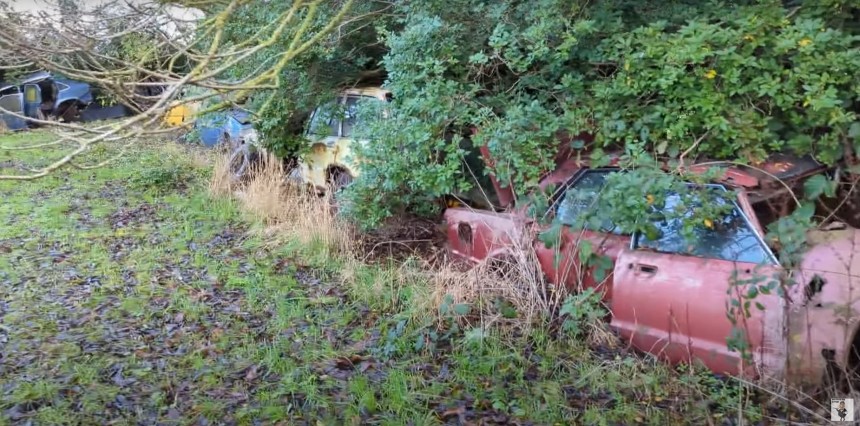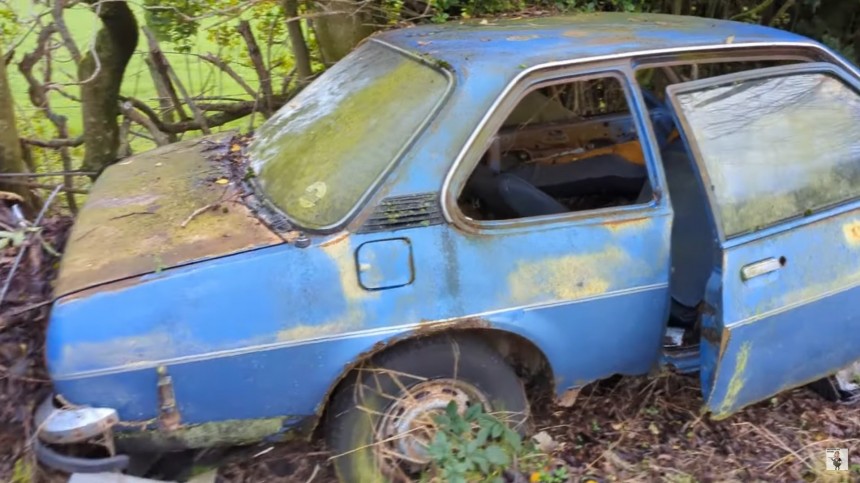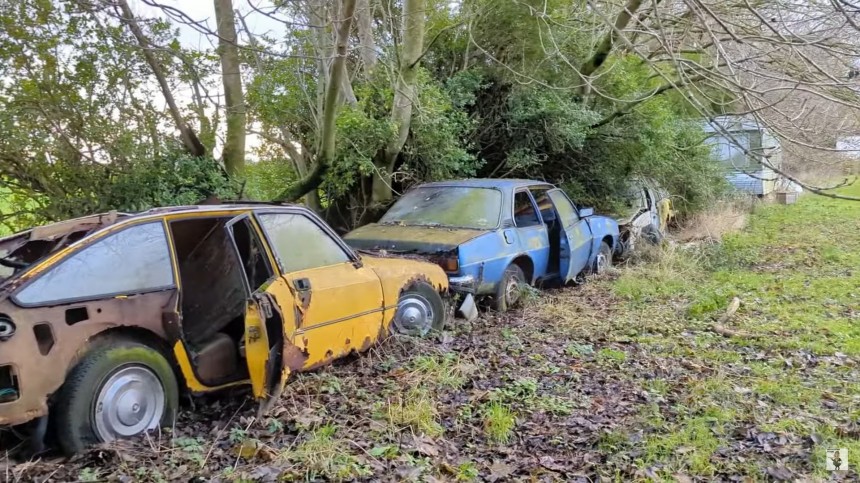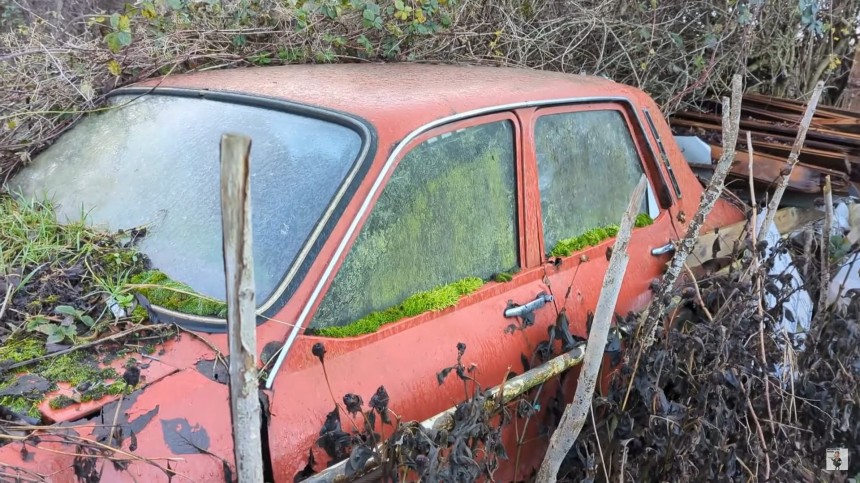A car graveyard may seem a rather sad sight to someone who doesn't love cars, but for enthusiasts, it can be an interesting place full of discoveries.
On the YouTube channel Out With The Butler, we discovered a video in which the presenter shows a place in the UK, where several caravans and cars have been amassed.
The first car that comes his way is a Mazda 323 1000. It appears to have been a green or yellow painted example, but the car has been outside so long that its original color is uncertain.
Only the rear end and headlight clusters retain clear traces that it is a Mazda 323. Being unveiled in January 1977, the original Mazda 323 was the Japanese manufacturer's first modern hatchback. What we see in that heap of ruined wreckage looks like the car that started a model line that stretches all the way to the Mazda3 of today.
The first-generation 323 was a compact rear-wheel drive vehicle that was introduced in the UK in 1977. The lineup consisted of the 1000 version, like the one in the video, with three doors (two doors + hatchback), and the three-door and five-door 1300 version.
Initially, all cars in the UK were equipped with the 1.3-liter four-cylinder engine producing 90 hp, linked to a four-speed manual gearbox as standard. A three-speed automatic gearbox was also available as an option. The Mazda 323 was a pioneer in the late 1970s and early 1980s when the popularity of hatchbacks was on the rise in Europe.
The next car that stands out is a Ford Cortina Mk IV (probably from 1978). The model was originally built by Ford of Britain and then by Ford of Europe in various guises between 1962 and 1982. The name was inspired by the Italian ski resort Cortina d'Ampezzo, where the 1956 Winter Olympics were held. The Cortina was the best-selling car in the UK in the 1970s.
It was produced in five generations, and from 1970 onwards, it was almost identical to the German-market Ford Taunus (it was based on the same platform). The Cortina was replaced in 1982 by the Ford Sierra. In Asia and Australasia, it was Ford Teslar that took its place.
Another model found among the abandoned cars is a blue Vauxhall Cavalier Mk1 which has retained some of its colors despite the weathering it has been exposed to.
The Cavalier was a family car sold mainly in the UK by Vauxhall between 1975 and 1995. It was based on a succession of Opel models over the years of production.
The first-generation Cavalier, launched in 1975 and produced until 1981, was based on models such as the Opel Ascona and Opel Manta. There were minor visual differences between them.
Although the Cavalier was originally intended to have its own bodywork, the front end was derived from that of the Opel Manta B, without the air slots between the headlights, and the rear end – from an Opel Ascona B model. Ultimately, the redesigned front end was the only obvious styling feature to differentiate the Vauxhall.
Another jewel car, so to speak, that sits next to that Vauxhall is a yellow Citroen GS. The GS had a front-mounted engine, also front-axle drive. The model was manufactured and marketed by Citroen in two series: for the 1970-1979 model years in saloon fastback and estate bodywork and later, as the GSA for the 1980-1989 model years in hatchback and estate bodywork. Production of the two series reached around 2.5 million units.
The avant-garde Citroen GS stood out with its aerodynamic body shape, with a drag coefficient of 0.318. The model had fully independent hydropneumatic brakes and self-leveling suspension. Also of note were the four disc brakes and the air-cooled 1,015-cc, 54-hp, four-cylinder boxer engine that made maintenance much easier.
The GS was named European Car of the Year in 1971, the design was noted as technologically advanced, and comfort, safety, and top aerodynamics were its main qualities.
In the last part of the video, the vlogger notices two other cars, two Renault 12s.
The Renault 12 was launched by the French car manufacturer at the Paris Motor Show in October 1969 and produced in France until 1980. Available as a saloon and estate, the Renault 12 was produced under license in many countries around the world.
Even though on video, it doesn't look like the owner appreciated it very much, at least in its later years, the 12 was praised by the European press at the time of its launch for its spacious and comfortable interior. The North American press, however, criticized the annoying engine noise and called the servo-less steering unwieldy. The ventilation system didn't get rave reviews either.
Production and sales of the Renault 12 ceased in Western Europe in 1980, but the model continued to roll off assembly lines in other parts of the world.
The last Renault 12 was produced in 2000 in Turkey, while Romanian car manufacturer Dacia continued to build the model under license as a saloon and estate called Dacia 1310 until 2004, and Dacia Pick-Up until December 2006.
The Renault 12 was sold in 2.5 million units and the figures only confirm that the model was a commercial success.
The first car that comes his way is a Mazda 323 1000. It appears to have been a green or yellow painted example, but the car has been outside so long that its original color is uncertain.
Only the rear end and headlight clusters retain clear traces that it is a Mazda 323. Being unveiled in January 1977, the original Mazda 323 was the Japanese manufacturer's first modern hatchback. What we see in that heap of ruined wreckage looks like the car that started a model line that stretches all the way to the Mazda3 of today.
Initially, all cars in the UK were equipped with the 1.3-liter four-cylinder engine producing 90 hp, linked to a four-speed manual gearbox as standard. A three-speed automatic gearbox was also available as an option. The Mazda 323 was a pioneer in the late 1970s and early 1980s when the popularity of hatchbacks was on the rise in Europe.
The next car that stands out is a Ford Cortina Mk IV (probably from 1978). The model was originally built by Ford of Britain and then by Ford of Europe in various guises between 1962 and 1982. The name was inspired by the Italian ski resort Cortina d'Ampezzo, where the 1956 Winter Olympics were held. The Cortina was the best-selling car in the UK in the 1970s.
Another model found among the abandoned cars is a blue Vauxhall Cavalier Mk1 which has retained some of its colors despite the weathering it has been exposed to.
The Cavalier was a family car sold mainly in the UK by Vauxhall between 1975 and 1995. It was based on a succession of Opel models over the years of production.
Although the Cavalier was originally intended to have its own bodywork, the front end was derived from that of the Opel Manta B, without the air slots between the headlights, and the rear end – from an Opel Ascona B model. Ultimately, the redesigned front end was the only obvious styling feature to differentiate the Vauxhall.
Another jewel car, so to speak, that sits next to that Vauxhall is a yellow Citroen GS. The GS had a front-mounted engine, also front-axle drive. The model was manufactured and marketed by Citroen in two series: for the 1970-1979 model years in saloon fastback and estate bodywork and later, as the GSA for the 1980-1989 model years in hatchback and estate bodywork. Production of the two series reached around 2.5 million units.
The GS was named European Car of the Year in 1971, the design was noted as technologically advanced, and comfort, safety, and top aerodynamics were its main qualities.
In the last part of the video, the vlogger notices two other cars, two Renault 12s.
The Renault 12 was launched by the French car manufacturer at the Paris Motor Show in October 1969 and produced in France until 1980. Available as a saloon and estate, the Renault 12 was produced under license in many countries around the world.
Production and sales of the Renault 12 ceased in Western Europe in 1980, but the model continued to roll off assembly lines in other parts of the world.
The last Renault 12 was produced in 2000 in Turkey, while Romanian car manufacturer Dacia continued to build the model under license as a saloon and estate called Dacia 1310 until 2004, and Dacia Pick-Up until December 2006.
The Renault 12 was sold in 2.5 million units and the figures only confirm that the model was a commercial success.
